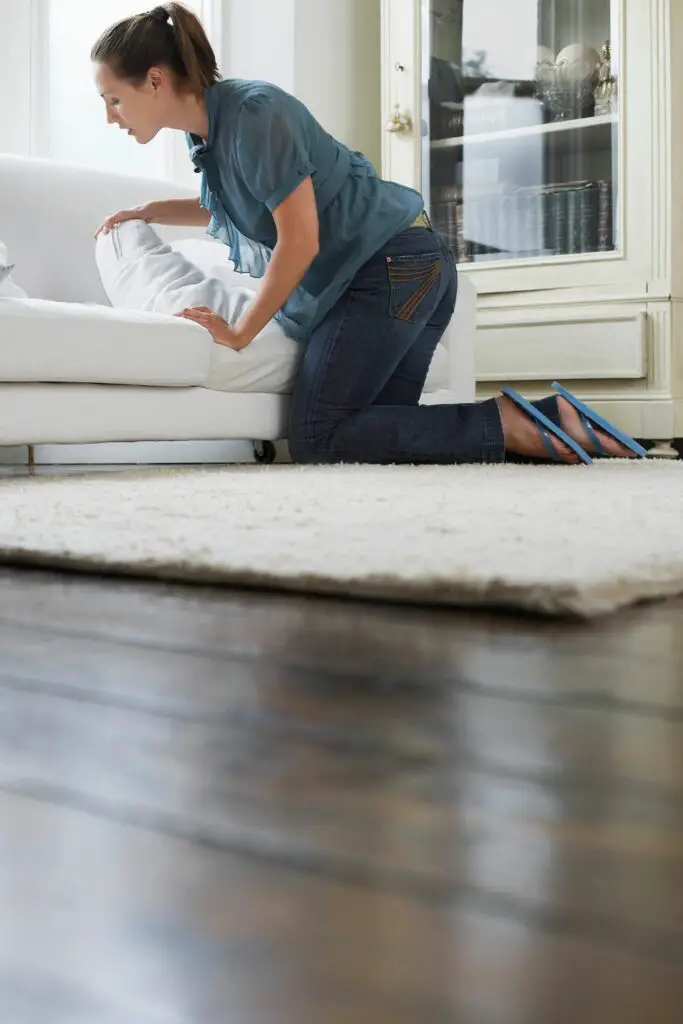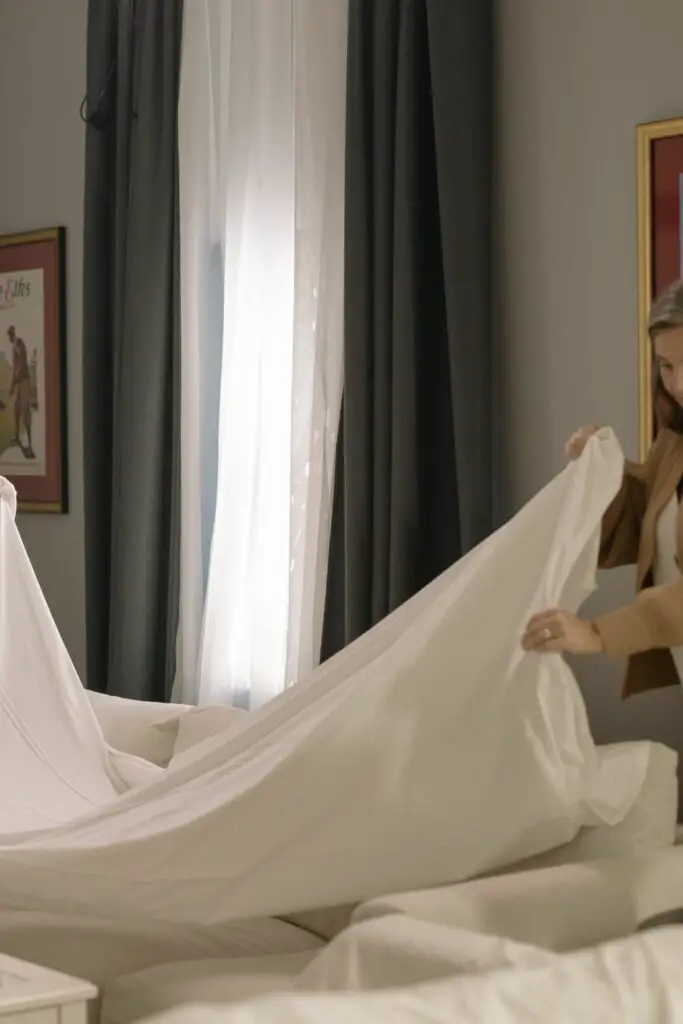Table of Contents Show
Having spent years as a homeowner and a contractor, I’ve had countless conversations about home maintenance with a wide range of clients. One question that comes up frequently is: Can you wash sofa covers?
Sofas are the centerpiece of many living rooms, and maintaining their appearance is essential for both homeowners and guests alike.
Sofa covers act as the first line of defense against spills, dust, and daily wear and tear. But when these protective layers get dirty or stained, the uncertainty arises—should we wash them, or is there a risk involved?
With a foundation built on experience and feedback from numerous satisfied clients, let’s break down the facts and dispel some myths about washing sofa covers. So, if you’re wondering how best to care for your sofa’s protective cover, read on for some straightforward, professional advice.
Quick Answer
Yes, you can wash sofa covers, but it’s essential to consider the material, care instructions, and potential for shrinkage or color bleeding. For best results, always read the care label, and when in doubt, opt for professional cleaning or alternative methods to preserve the cover’s longevity and appearance.
General Guidelines for Washing Sofa Covers

Before launching into the specifics of cleaning different types of sofa covers, there are some general guidelines that every homeowner should follow. These guidelines ensure not just the longevity of the cover but also its continued aesthetic appeal.
1. Always Read The Care Label
This might seem like a no-brainer, but you’d be surprised how many people overlook this simple step. Manufacturers provide care labels for a reason. They guide you on the best practices for maintaining the product’s integrity. Ignoring this label might result in damage or a shortened lifespan for your cover.
2. Pre-treat Any Stains
Accidents happen. Whether it’s a spilled glass of wine or a drop of ketchup, immediate action can save your sofa cover from permanent staining. Before tossing your cover into the washing machine or hand-washing it, treat any stains with a suitable stain remover. This will enhance the chances of completely removing the blemish during the wash.
3. Test a Small, Inconspicuous Area First
Before you fully commit to washing the entire cover, especially if you’re using a new cleaning product, it’s always wise to test a small hidden section. This step ensures that the product won’t adversely affect the color or fabric of the cover.
According to a study published in the Journal of Household and Personal Products, consistent and proper care of fabric-based products can significantly extend their usable life. This not only reinforces the importance of regular maintenance but also emphasizes the need to follow the correct cleaning procedures.
Washing Fabric Sofa Covers
Fabric sofa covers are a popular choice in many homes due to their comfort and versatility. However, they can also accumulate dirt, dust, and occasional spills over time. But fear not! With the right approach, these covers can be kept looking fresh and new. Here’s how:
1. Machine Washing Tips
- Use cold water and mild detergent: Cold water is gentle on most fabric materials, reducing the risk of shrinkage or color bleeding. Pair this with a mild detergent to ensure effective cleaning without any undue harshness on the fabric.
- Avoid Bleach and Harsh Chemicals: While bleach may be a go-to for stain removal, it can be too aggressive for many fabrics, potentially causing discoloration or weakening the fabric fibers. Always opt for fabric-specific cleaning agents.
- Opt For a Gentle Cycle: A gentle or delicate cycle on your washing machine ensures that the fabric isn’t subjected to aggressive spinning, which can stretch or misshape the cover.
2. Hand Washing Tips
- Use lukewarm water and a soft cloth. Lukewarm water is effective for cleaning without being too hot, which could damage the fabric. A soft cloth or sponge helps lift dirt without being abrasive.
- Dab gently, don’t scrub. It’s tempting to scrub at a stain or dirty spot, but this can fray the fabric. Instead, dab gently and let the cleaning solution do its work.

3. Drying Tips
Avoid direct sunlight to prevent color fading. Direct sunlight can bleach the colors of your sofa cover, leading to uneven fading. Find a shaded area or an indoor spot for drying.
Opt for air drying or use a tumble dryer on a low setting. Air drying is the gentlest method, preserving the shape and size of your cover. If time is a constraint, a tumble dryer on a low heat setting can also be used, but ensure that the cover is not left in for too long to avoid shrinkage.
By adhering to these guidelines, you’ll ensure that your fabric sofa covers remain vibrant and in top condition for years to come.
Caring for Leather or Faux Leather Covers
Leather and faux leather sofa covers exude a sense of luxury and elegance in any living space. But with this sophistication comes the responsibility of specialized care. Unlike fabric covers, leather-based materials require a different approach to cleaning and maintenance to keep them looking their best.
1. Avoid Submerging in Water
Leather and faux leather are not designed to handle excessive moisture. Immersing them in water can lead to warping, discoloration, or even mold growth. Instead of a thorough wash, opt for targeted cleaning methods.
2. Use a Damp Cloth for Spot Cleaning
For minor stains or accumulated dirt, a damp cloth is all you need. Simply wipe the affected area gently. If using a cleaner, ensure it’s specifically formulated for leather or faux leather. Remember to always test any cleaning agent on an inconspicuous area first to ensure it won’t damage or discolor the material.
3. Conditioning Leather Post-Cleaning to Prevent Cracks
One of the challenges with leather is that it can dry out over time, leading to cracks or splits. To counteract this, it’s essential to apply a leather conditioner after cleaning. This not only restores the leather’s natural moisture but also provides a protective layer against spills and stains.
For faux leather, while it doesn’t require conditioning in the same way genuine leather does, using a protective spray can help maintain its appearance and durability.
When treated with care and attention, leather and faux leather sofa covers can offer both comfort and a touch of class for many years. Remember, the key is in understanding the material’s unique needs and catering to them accordingly.
Maintaining Velvet or Plush Covers
Velvet and plush sofa covers are synonymous with luxury and coziness. Their soft texture and sheen add a touch of opulence to any living space. However, their distinct texture also means they can trap more dirt and dust than smoother fabrics. Proper care is paramount to maintain their lush appearance and feel.
1. Vacuum Regularly
The plush nature of these fabrics means they can harbor dust, pet hair, and other small particles quite easily. Regularly vacuuming the surface using an upholstery attachment can help remove this debris, keeping the covers looking clean and fresh.
This routine will not only keep the material looking pristine but will also prevent dirt from becoming embedded into the fibers.
2. Spot Clean With a Gentle Detergent
Spills and stains are inevitable. When they occur, it’s essential to act quickly. Blot the spill gently with a clean, dry cloth to absorb as much as possible. Then, using a cloth dampened with a mixture of lukewarm water and a gentle detergent, dab the stained area.
Avoid scrubbing as this can damage the fibers and affect the fabric’s appearance. Always rinse out the detergent with another damp cloth to prevent residue.
3. Avoid Wringing or Twisting
If your velvet or plush cover becomes wet, resist the urge to wring it out. Wringing or twisting can distort the fabric’s shape and damage its fibers. Instead, gently press between towels to remove excess moisture and lay flat to dry. Ensure the cover is completely dry before placing it back on the sofa to prevent any mold or mildew formation.
With careful maintenance, velvet and plush sofa covers can continue to be a statement piece in your living area, radiating warmth and sophistication for years to come.
Factors to Consider Before Washing
While the idea of giving your sofa covers a thorough cleaning might sound appealing, it’s crucial to consider certain factors that can influence the outcome. Here’s what you need to keep in mind before embarking on the washing process:
1. Size And Fit: Risk of Shrinkage
One of the primary concerns homeowners express is the potential for sofa covers to shrink after washing. Even a slight reduction in size can make it challenging to fit the cover back onto the sofa snugly.
Always follow the manufacturer’s instructions regarding washing temperatures and drying methods. If in doubt, consider hand washing or using cold water, and always opt for air drying to minimize this risk.
2. Colorfastness: Potential For Colors to Bleed
Especially with brightly colored or patterned covers, there’s a possibility that colors might run or bleed. This is especially true for covers that haven’t been washed before.
A simple test can be done by dampening a white cloth and rubbing it on an inconspicuous part of the cover. If any color transfers, it’s a sign that you need to be cautious. In such cases, it might be wise to either hand wash the cover separately or consult professional cleaners.
3. Age And Condition: Older Covers May be Fragile
Like any other piece of fabric, wear and tear can take a toll on sofa covers over time. Older covers, or those exposed to direct sunlight or frequent use, might be more susceptible to damage. Before washing, inspect the cover for any weak spots, tears, or areas that appear worn out. If the cover seems fragile, consider a gentler cleaning method or seek professional advice.
In summary, while washing sofa covers can refresh and rejuvenate them, it’s essential to approach the task with care and consideration. By understanding and weighing these factors, you’re better equipped to make decisions that will preserve the lifespan and appearance of your covers.
Post-Washing Care
Once your sofa covers have undergone the washing process, the care doesn’t end there. Proper post-washing practices are equally vital to maintain the shape, appearance, and longevity of your covers. Here’s what you should focus on:
1. Reshaping Covers While Damp
When sofa covers are removed from the washing machine or hand washing basin, they may appear misshapen or wrinkled. Before letting them dry, it’s a good practice to gently reshape them.
Lay the covers flat on a clean surface or hang them up, smoothing out any wrinkles or distortions by hand. This step helps the covers retain their original shape, ensuring a better fit when placed back on the sofa.
2. Ironing tips (if suitable)
- Check the care label: Before you even think of ironing your sofa cover, it’s essential to refer to the care label. Some materials, especially synthetic ones, can melt or get damaged under high heat.
- Use the right temperature setting: Depending on the fabric, choose the appropriate heat setting on your iron. For delicate fabrics like silk or velvet, use a low heat setting. Cotton or linen covers can typically handle higher temperatures.
- Consider using a pressing cloth: To avoid direct contact between the iron and the sofa cover, you can place a thin white cloth or towel over the cover. This protective layer ensures even heat distribution and reduces the risk of scorch marks or shine.
- Iron inside out: If your sofa cover is reversible, consider ironing it inside out. This protects the outer appearance from potential shine or discoloration caused by ironing.
- Use steam for stubborn wrinkles: If your iron has a steam function, it can be beneficial for removing deep-set wrinkles. However, ensure the fabric type is suitable for steam ironing first.
With these post-washing care tips in hand, you’re well-equipped to ensure that your sofa covers not only come out clean but also maintain their shape and beauty for the long run.
Alternatives to Washing
While regular washing is one way to keep sofa covers looking and feeling fresh, it’s not the only solution. Sometimes, you might be dealing with delicate fabrics, antique covers, or simply looking for a less labor-intensive approach. In such scenarios, alternative cleaning methods come into play. Here are some of the top alternatives to the traditional washing routine:
1. Professional Cleaning Services
- Specialized care: Professional cleaners possess the expertise and equipment to handle various fabric types, ensuring your sofa covers receive the best care possible.
- Stain removal: Stubborn stains that resist home remedies can often be tackled effectively by professionals.
- Convenience: Handing your covers over to experts means you save time and effort, making it an excellent option for busy homeowners.

2. Steam Cleaning
- Deep cleaning without immersion: Steam cleaning penetrates deep into the fabric, lifting dirt and killing germs without the need for submerging the cover in water.
- Suitable for sensitive fabrics: As there’s no aggressive rubbing or wringing involved, steam cleaning can be ideal for delicate or antique covers.
- Quick drying: The moisture from steam evaporates faster than water, ensuring quicker drying times and reducing the risk of mold or mildew.
3. Using Fabric Fresheners or Sprays
- Instant freshness: For times when your covers don’t need a deep clean but could use some freshening up, fabric sprays can be a lifesaver. A quick spritz can instantly revitalize the scent and feel of your sofa.
- Stain repellents: Some sprays offer the added benefit of making the fabric resistant to future stains.
- Easy maintenance: Incorporating fabric sprays into your routine can extend the time between more intensive cleanings, making overall maintenance easier.
While washing remains a popular and effective method for cleaning sofa covers, it’s reassuring to know that there are other trustworthy alternatives at your disposal.
Depending on your needs, preferences, and the specific challenges presented by your sofa covers, you can choose the method that works best for you.













